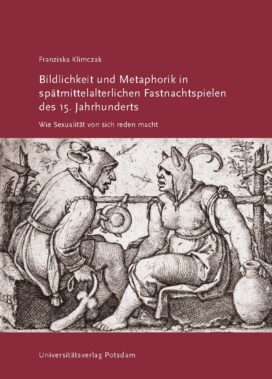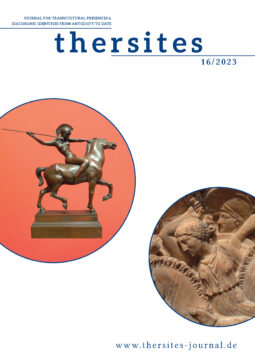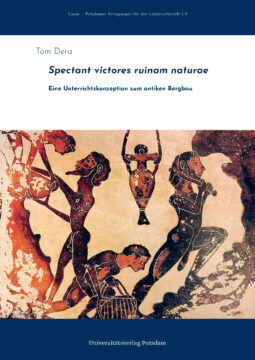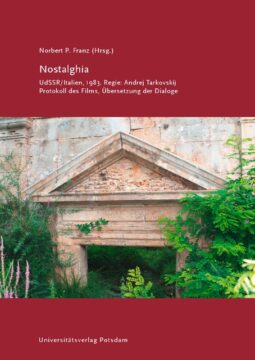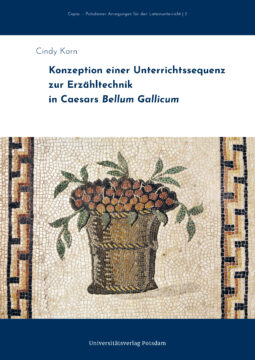The thesis examines sexual metaphoricity in the Nuremberg Shrovetide play of the 15th century. Textual basis is the edition of Adelbert von Keller, the only existing complete Collection of the Nuremberg Shrovetide play.¹ The objective of the thesis is to showcase the unique vocabulary of the Nuremberg Shrovetide play by concentrating on the imagery and metaphoricity of obscene sexual language and reflecting on its meaning and effect in the sociohistorical context. The thesis explores how the metaphor deliberately legitimates tabooed, intimate topics for the purpose of comical effect by discussing relevant theoretical discourses and critically reflecting upon it in the analysis of the text.
In an interdisciplinary approach the thesis discusses concepts and theories in different research areas such as Shrovetide plays, the Middle Ages, the metaphor and the comedy. Within the diversified scholarly discourse on Shrovetide plays the Nuremberg Shrovetide play is examined from the perspective to its topics, functions, gender constructions, and linguistics in order to gain a better understanding of its language. By contrasting genre-specific, theological-normative and literary discourses, the thesis analyses the medieval married and family life as well as the social and legal status of men and women. Thereby the logics and procedures in medieval everyday, religious, and legal practice can be revealed. This allows an evaluation of figurative representations of the human body in the Nuremberg Shrovetide play. These representations negotiate the medieval sexual morals and display the manifold imagery and ideas of men and women. After a discussion of relevant theories on the metaphor the thesis explores how metaphorical language opens the door to obscene topics and at the same time keeps them at bay. In order to describe the metaphorical mode of action and effect poststructural, epistemological, cognitive, semantic, and philosophical theories are considered. Here, analogy-based and function-oriented approaches prove the most productive, as they regard the contextuality of the metaphor as effectual and discuss metaphors as complex metacognitive phenomena based on interaction and processes of transfer. Thereafter, laughter in medieval society is discussed taking account of its reasons, social forms and functions. In this way, the comical, rough-and-sensual style of the Shrovetide play becomes transparent. The entertainment quality of the language of the Shrovetide play can be illustrated by raising the awareness of recurring comical elements and patterns. Subsequently, a comprehensive analysis of the Nuremberg Shrovetide play is guided by Hans Georg Coenen’s theory of figurative language.² His definition of analogy, which can be viewed in line with classical rhetorics, differentiates between creative, conventional and lexicalised metaphors. Due to the extraordinary variety of sexual metaphors in the Shrovetide plays, the analysis concentrates on the representations of male and female sexual organs and the coitus.
The author of this thesis draws the following conclusions: By using figurative metaphors, the Nuremberg Shrovetide play renders sexuality representable, as it does not strike the reader with immediate directness. The many images of peasant, everyday life aestheticise sexual motifs – whether they exaggerate or understate, depreciate or valorize, cover or expose. As the metaphor shows sexuality from an unfamiliar perspective, it appears at a distance. This alone allows and justifies the excessive talk of sexuality in the Nuremberg Shrovetide play. Sexual metaphors frequently show the penis as a donkey, the vagina as a meadow and coitus as a spear fight. By this, familiar ideas of men and women along with normative expectations and hierarchies of married life are turned upside down. This could and still can be perceived today as obscene and indecent, but also as amusing and entertaining. The metaphor always remains ambiguous in this language game. The poetic talent and comical quality of the Nuremberg Shrovetide play arise from its multi-channel mode of action, innovative power of language and contradictory nature. The skilful, metaphorical language of the Nuremberg Shrovetide play is contrasted with the physicality demonstrated in the plays.
The thesis illustrates the innovative, critical potential of language of the Nuremberg Shrovetide play. In consequence, its language can be viewed as a poetics of ambiguity and thus valued for its wealth of expressions for the human sexual sphere. The thesis makes a significant contribution to the linguistic and literary analysis of the Nuremberg Shrovetide play and contributes to a differentiated understanding of its cultural-historical meaning and significance.
1 Keller, Adelbert von: Fastnachtspiele aus dem 15. Jahrhundert. 4 Bde., 1853-1858
2 Coenen, Hans Georg: Analogie und Metapher: Grundlegung einer Theorie der bildlichen Rede. Walter de Gruyter, Berlin: 2002, 85 ff.
gestellt an Franziska Klimczak

